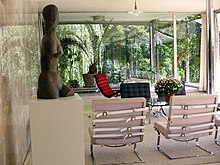
The Staatliches Bauhaus, commonly known as the Bauhaus, was a German art school operational from 1919 to 1933 that combined crafts and the fine arts. The school became famous for its approach to design, which attempted to unify individual artistic vision with the principles of mass production and emphasis on function.
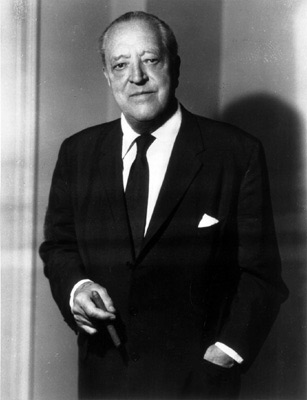
Ludwig Mies van der Rohe was a German-American architect and furniture designer. He was commonly referred to as Mies, his surname. Along with Alvar Aalto, Le Corbusier, Walter Gropius and Frank Lloyd Wright, he is regarded as one of the pioneers of modernist architecture.

Villa Tugendhat is an architecturally significant building in Brno, Czech Republic. It is one of the pioneering prototypes of modern architecture in Europe, and was designed by the German architects Ludwig Mies van der Rohe and Lilly Reich. It was built between 1928 and 1930 for Fritz Tugendhat and his wife Greta, of the wealthy and influential Jewish Tugendhat family. Of reinforced concrete, the villa soon became an icon of modernism. Famous for its revolutionary use of space and industrial building materials, the building was added to the UNESCO World Heritage List in 2001.

The Barcelona chair is a chair designed by Ludwig Mies van der Rohe and Lilly Reich, for the German Pavilion at the International Exposition of 1929, hosted by Barcelona, Catalonia, Spain.

The Barcelona Pavilion, designed by Ludwig Mies van der Rohe and Lilly Reich, was the German Pavilion for the 1929 International Exposition in Barcelona, Spain. This building was used for the official opening of the German section of the exhibition. It is an important building in the history of modern architecture, known for its simple form and its spectacular use of extravagant materials, such as marble, red onyx and travertine. The same features of minimalism and spectacular can be applied to the furniture specifically designed for the building, including the Barcelona chair. It has inspired many important modernist buildings.

In architecture, functionalism is the principle that buildings should be designed based solely on their purpose and function. An international functionalist architecture movement emerged in the wake of World War I, as part of the wave of Modernism. Its ideas were largely inspired by a desire to build a new and better world for the people, as broadly and strongly expressed by the social and political movements of Europe after the extremely devastating world war. In this respect, functionalist architecture is often linked with the ideas of socialism and modern humanism.
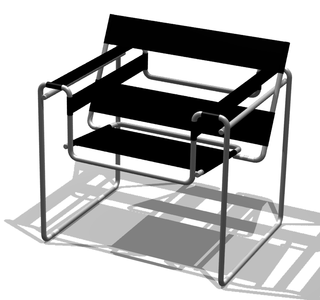
The Wassily Chair, also known as the Model B3 chair, was designed by Marcel Breuer in 1925–1926 while he was the head of the cabinet-making workshop at the Bauhaus, in Dessau, Germany.
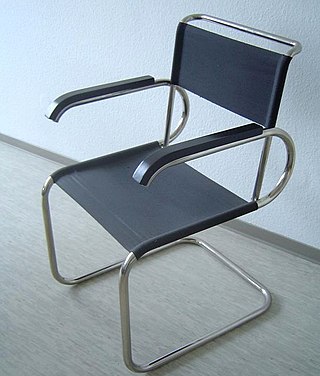
A cantilever chair is a chair whose seating and framework are not supported by the typical arrangement of 4 legs, but instead is held erect and aloft by a single leg or legs that are attached to one end of a chair's seat and bent in an L shape, thus also serving as the chair's supporting base. Nearly a century after its inception, tubular steel remains the prime choice for the cantilever chair with Marcel Breuer being perhaps the greatest champion of this design technique; using the overhanging cantilever styling in both his furniture and architecture. Ludwig Mies van der Rohe and Alvar Aalto are other historical figures who contributed to the popularity of the cantilever chair.
The Tugendhat family was a family of Czech-Jewish textile and oil industrialists. World War II scattered them through Europe and America, and descendants have become influential politicians and academics.

The Brno chair is a modernist cantilever chair designed by Ludwig Mies van der Rohe and Lilly Reich in 1929-1930 for the bedroom of the Tugendhat House in Brno, Czech Republic. The design was based on similar chairs created by Mies van der Rohe also working with Lilly Reich, such as the MR20 chair with wicker seat from 1927; all building on earlier designs of Mart Stam.

Lilly Reich was a German designer of textiles, furniture, interiors, and exhibition spaces. She was a close collaborator with Ludwig Mies van der Rohe for more than ten years during the Weimar period in the 1920s and early 1930s. Reich was an important figure in the early Modern Movement in architecture and design. Her fame was posthumous, as the significance of her contribution to the work of Mies van der Rohe and others with whom she collaborated only became clear through the research of later historians of the field.

Modern furniture refers to furniture produced from the late 19th century through the present that is influenced by modernism. Post-World War II ideals of cutting excess, commodification, and practicality of materials in design heavily influenced the aesthetic of the furniture. It was a tremendous departure from all furniture design that had gone before it. There was an opposition to the decorative arts, which included Art Nouveau, Neoclassical, and Victorian styles. Dark or gilded carved wood and richly patterned fabrics gave way to the glittering simplicity and geometry of polished metal. The forms of furniture evolved from visually heavy to visually light. This shift from decorative to minimalist principles of design can be attributed to the introduction of new technology, changes in philosophy, and the influences of the principles of architecture. As Philip Johnson, the founder of the Department of Architecture and Design at the Museum of Modern Art articulates:
"Today industrial design is functionally motivated and follows the same principles as modern architecture: machine-like simplicity, smoothness of surface, avoidance of ornament ... It is perhaps the most fundamental contrast between the two periods of design that in 1900 the Decorative Arts possessed ..."

Knoll, is an American company that manufactures office systems, seating, storage systems, tables, desks, textiles, as well as accessories for the home, office, and higher education. The company is the licensed manufacturer of furniture designed by notable architects and designers such as David Adjaye, Harry Bertoia, Ludwig Mies van der Rohe, Florence Knoll, Frank Gehry, Charles Gwathmey, Maya Lin, Marc Newson, Ini Archibong, Eero Saarinen, and Lella and Massimo Vignelli, under the company's KnollStudio division. Over 40 Knoll designs can be found in the permanent design collection of the Museum of Modern Art in New York City.
Jan Ruhtenberg was an architect who "made significant contributions in introducing modern architecture to the United States as a teacher and a modern architect".
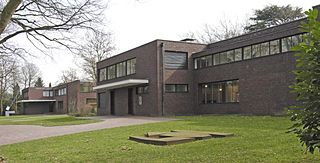
Haus Lange and Haus Esters are two residential houses designed by Ludwig Mies van der Rohe in Krefeld, Germany, for German industrialists Hermann Lange and Josef Esters. They were built between 1928 and 1930 in the Bauhaus style. The houses have now been converted into museums for Contemporary art.

Willem Hendrik Gispen was a Dutch industrial designer, best known for his Giso lamps and serially produced functionalist steel-tube furniture.
Charles Randolph Pollock was an industrial designer who created sleek furniture, most notably an office chair held together by a single aluminum band that became known as a Pollock Chair. This iconic chair, introduced in 1963 and still in production, became a staple of executive offices in the United States in the 1960s and can be seen, appropriately, in the period television show, Mad Men, as well as institutions such as the Smithsonian Institution and the Metropolitan Museum of Art

The Campeche is a reclining, non-folding, sling-seat chair with a distinctive side-placed curule base. In North America, they are named for the Campeche region of Mexico's Yucatán Peninsula, and were popular in the Americas during the early nineteenth century. Similar versions of the form are found throughout Europe, such as the Schinkel writing chair at Schloss Charlottenburg in Berlin. Other related forms include the "planter's chair" or "bootjack" which is associated with equatorial climes and plantation-based societies.

The Weissenhof chair is a chair designed by the German architect and designer Ludwig Mies van der Rohe, in 1927. This first, springy cantilever chair was shown at the Weissenhofsiedlung Exhibition in 1927. It was made of 25 mm steel tube and with a wicker framework proposed by Lilly Reich. The MR20 version has forearms.
